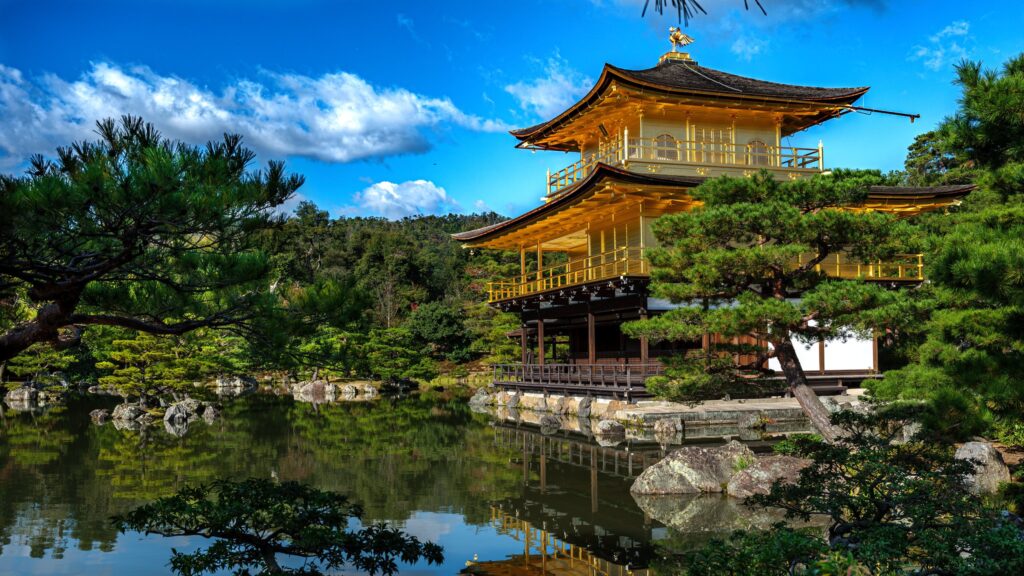Kinkaku-ji: The Golden Pavilion of Kyoto

In the ancient city of Kyoto, Japan, amidst the tranquil surroundings of lush gardens and serene ponds, stands a shimmering testament to beauty, spirituality, and architectural splendor – Kinkaku-ji, the Golden Pavilion. Adorned in gold leaf and reflecting the ethereal beauty of its surroundings, Kinkaku-ji has captured the imagination of travelers for centuries, drawing pilgrims and poets alike to its sacred precincts. With its storied history, breathtaking beauty, and profound spiritual significance, Kinkaku-ji stands as a timeless symbol of Japan’s rich cultural heritage and enduring legacy of craftsmanship.
A Gilded Legacy: Origins and History
The history of Kinkaku-ji dates back to the 14th century when it was originally built as a retirement villa for Ashikaga Yoshimitsu, a powerful shogun and patron of the arts. Inspired by the beauty of the surrounding landscape, Yoshimitsu adorned the upper floors of the pavilion with gold leaf, transforming it into a radiant beacon of opulence and elegance.
Following Yoshimitsu’s death, Kinkaku-ji was converted into a Zen Buddhist temple in accordance with his final wishes. Over the centuries, the pavilion underwent several reconstructions and renovations, each time faithfully restoring its iconic golden façade and preserving its timeless beauty for future generations to admire.
The Architecture of Enlightenment: Design and Symbolism
Kinkaku-ji’s architectural design is a masterpiece of harmony and balance, reflecting the principles of Zen Buddhism and the aesthetics of traditional Japanese architecture. The pavilion’s three-tiered structure, with each floor showcasing a different architectural style – Shinden-zukuri (palace), Samurai-zukuri (samurai house), and Zen Hall – symbolizes the progression from earthly desires to spiritual enlightenment.
The top two floors of Kinkaku-ji are covered in gold leaf, symbolizing the purity of the Buddha nature and the transcendence of worldly attachments. The pavilion’s reflection in the tranquil waters of Kyoko-chi (Mirror Pond) creates a mesmerizing effect, evoking a sense of otherworldly beauty and spiritual serenity.
A Garden of Tranquility: The Surrounding Landscape
Surrounding Kinkaku-ji is a meticulously landscaped garden that reflects the harmony of nature and the human spirit. Designed to complement the pavilion’s beauty and enhance its spiritual significance, the garden features winding paths, lush foliage, and carefully cultivated trees and shrubs.
The garden’s centerpiece is Kyoko-chi, a tranquil pond that mirrors the golden pavilion and creates a sense of unity between heaven and earth. Islands, bridges, and stone lanterns dot the landscape, providing focal points for contemplation and meditation amidst the serene beauty of nature.
Cultural Reverence: Kinkaku-ji in Art and Literature
Throughout history, Kinkaku-ji has inspired countless artists, poets, and writers with its breathtaking beauty and spiritual significance. From traditional ink paintings and woodblock prints to contemporary photographs and novels, the golden pavilion has been immortalized in various forms of artistic expression, each capturing a different facet of its timeless allure.
In literature, Kinkaku-ji has been celebrated in works such as “The Temple of the Golden Pavilion” by Yukio Mishima, a novel that explores themes of beauty, obsession, and spiritual decay. In art, the pavilion has been depicted in iconic masterpieces by renowned artists such as Katsushika Hokusai and Utagawa Hiroshige, whose prints capture the essence of Kinkaku-ji’s ethereal beauty and transcendent spirituality.
A Pilgrimage for the Soul: Visiting Kinkaku-ji
For visitors to Kyoto, Kinkaku-ji is more than just a tourist attraction; it’s a pilgrimage for the soul. As visitors approach the pavilion, they are greeted by the sight of its golden façade shimmering in the sunlight, its reflection dancing on the surface of the pond below.
Stepping through the gates of Kinkaku-ji, visitors are transported to a world of tranquility and serenity, where the cares of the world seem to fade away amidst the timeless beauty of the pavilion and its surroundings. Whether exploring the garden paths, meditating by the pond, or simply gazing in wonder at the golden pavilion, every moment spent at Kinkaku-ji is an opportunity for reflection, renewal, and spiritual awakening.
A Symbol of Beauty and Enlightenment
In a world filled with chaos and uncertainty, Kinkaku-ji stands as a beacon of beauty and enlightenment – a reminder of the enduring power of art, architecture, and spirituality to uplift the human spirit and transcend the boundaries of time and space. As visitors depart from its sacred precincts, their hearts filled with the echoes of its golden beauty and timeless wisdom, they carry with them a deeper appreciation for the profound mysteries of life and the boundless potential of the human soul.




